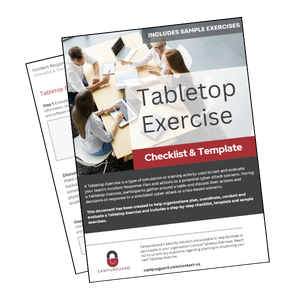
In today’s healthcare environment, the stakes are higher than ever. Patient safety is no longer just about clinical care. It’s also about ensuring that critical systems, sensitive data, and life-saving equipment are protected from threats.
Cyberattacks, ransomware incidents, supply chain disruptions, and even natural disasters can disrupt care delivery in an instant. For healthcare organizations, tabletop exercises have become a vital tool for testing readiness, strengthening response capabilities, and protecting both patients and operations.
Emerging Threats Facing Healthcare Organizations
Healthcare continues to lead as the costliest industry for data breaches, with an average breach cost of $7.42 million, the highest across all sectors for the 14th consecutive year, according to IBM’s latest Cost of a Data Breach Report.
The persistent targeting of patient personal identification information (PII) by attackers underscores its value for identity theft, insurance fraud, and other financial crimes. Notably, breaches in healthcare also take the longest to detect and resolve, averaging 279 days to identify and contain.
As one of the most targeted sectors for cybercriminals, the healthcare industry’s risks extend beyond stolen data: system downtime or compromised devices can directly impact patient health. Key threats include:
- Ransomware targeting critical systems: Disabling Electronic Health Records (EHRs), radiology systems, or surgical scheduling.
- Medical device vulnerabilities: Exploiting infusion pumps, imaging machines, and monitoring equipment.
- Third-party and supply chain breaches: Compromising vendors or cloud services used in patient care.
- Phishing and credential theft: Manipulating busy clinical staff through targeted social engineering.
- Natural disasters and infrastructure failures: Hurricanes, power outages, or water damage disrupt facility operations.
- Data integrity attacks: Altering patient records or lab results to cause confusion or harm.
Benefits of Conducting Tabletop Exercises in Healthcare
With such a complex risk landscape, healthcare organizations must not only anticipate attacks but also simulate their response under pressure. Tabletop exercises offer a controlled environment to walk through layered threats, uncover gaps in protocol, and refine the interaction between technology, clinical workflows, and emergency management.
When teams rehearse their responses, they expose weaknesses before real-world consequences arise, transforming lessons learned into actionable improvements for safety and resilience. Here are some of the benefits of conducting tabletop exercises for your healthcare organization:
- Protects Patient Safety During Disruptions
- Tabletop exercises simulate worst-case scenarios, helping staff understand exactly how to maintain safe, continuous care when technology, equipment, or facilities are compromised.
- Teams learn how to prioritize urgent care, safeguard life-critical devices, and implement manual backup procedures when automated systems fail.
- Improves Speed and Clarity of Incident Response
- By practicing in a low-pressure environment, healthcare teams develop muscle memory for decision-making during crises.
- Familiarity with escalation procedures, communication protocols, and the chain of command means less time wasted figuring out “who does what” when every second matters.
- Strengthens Cross-Department Communication
- Collaborating with other departments breaks down silos between IT/security, clinical staff, administration, compliance, and public relations.
- Tabletop exercises build a shared understanding of priorities (e.g., IT focuses on system restoration while clinicians concentrate on safe patient care).
- Reveals Gaps in Preparedness Before Real Incidents
- Exercises uncover overlooked vulnerabilities, such as untested backup systems, outdated contact lists, or unclear vendor responsibilities. Ensuring documentation is up to date (and available both online and offline) is critical.
- Identified gaps can be addressed proactively, reducing the likelihood of real-world failures.
- Enhances Regulatory and Legal Readiness
- Being prepared demonstrates due diligence for HIPAA and other compliance requirements.
- Providing documentation of proactive measures can be critical during audits, investigations, or post-incident litigation.
- Ensures Vendor and Partner Alignment
- Many healthcare incidents involve third parties, such as lab services, equipment manufacturers, or cloud providers.
- Tabletop exercises test whether external partners can coordinate effectively and meet their contractual obligations during an emergency.
- Improves Public and Patient Communication
- Role-playing during exercises allows teams to practice clear, compliant, and empathetic messaging for patients, families, media, and regulators.
- Exercises reduce the risk of misinformation, panic, or reputational damage during real events.
- Supports Business Continuity and Financial Stability
- Rapid recovery from disruptions helps avoid lost revenue, costly downtime, and reputational harm. A tabletop exercise can help shape your Business Impact Analysis and determine recovery time objectives for critical systems.
- Preventing prolonged outages decreases the likelihood of cancelled surgeries, delayed treatments, and operational backlogs.
- Identifies Resource Gaps and Prioritizes Funding
- By walking through a potential incident, organizations can uncover what resources are needed and where deficiencies might exist (i.e., lack of personnel, insufficient equipment, etc.).
- Prioritizing resource allocation based on impact allows organizations to make decisions and budget accordingly, addressing the most critical needs first.
- Builds a Culture of Preparedness
- Ongoing tabletop exercises embed a mindset of vigilance and readiness throughout the organization.
- Staff gain confidence in their ability to handle emergencies, leading to less panic and more coordinated action when incidents occur.
Potential Scenarios to Practice
When designing tabletop exercises for healthcare, the scenarios should be realistic, time-sensitive, and directly tied to patient safety. Examples include:
- Ransomware Attack During Peak Hours: EHRs, imaging systems, and patient portals are suddenly inaccessible.
- Compromised Medical Device: A network-connected ventilator or infusion pump is discovered to be sending inconsistent readings.
- Phishing Campaign Targeting Physicians: A malicious email leads to credential theft and unauthorized access to records.
- Power Outage in the ICU: Backup generators activate, but partial systems fail to restart.
- Delayed Lab Results Due to Vendor Breach: Critical test results can’t be delivered, impacting urgent treatment decisions.
- Misconfigured Cloud Storage: Exposing thousands of patient records online.
Check out our Tabletop Exercise Checklist and Template to access a pre-planning checklist, steps for how to conduct a tabletop exercise, and more.
Best Practices for Success in Healthcare Tabletop Exercises
- Keep Scenarios Current and Relevant
- Create scenarios on the latest emerging cyber and operational threats in the healthcare sector, such as ransomware targeting EHR systems, supply chain interruptions for critical medications, or compromised medical devices.
- Update them annually to reflect new technology deployments, regulatory changes, and recent incidents in the industry.
- Use real-world case studies from other hospitals or health systems to make scenarios tangible.
- Involve Executive Leadership and Decision-Makers
- Include C-suite leaders (CEO, CIO, CISO, COO, CMIO) so high-level policy and funding decisions can be tested in real time.
- When executives participate, exercises are more realistic, and follow-up improvements are more likely to be implemented.
- Encourage Cross-Department Collaboration
- Ensure representation from clinical, administrative, IT, security, compliance, facilities, legal, and public relations teams.
- Remember to include frontline staff in the exercises, those who will execute many response steps, not just leadership.
- Assign clear roles in advance, but test flexibility by throwing in unexpected role absences.
- Simulate Real-World Complexity
- Use progressive injects, new developments added during the exercise, to mimic how crises evolve.
- Include simultaneous pressures: for example, a cyberattack on EHRs while a regional disaster increases patient volume.
- Incorporate external stakeholders such as EMS, law enforcement, and vendors if applicable.
- Track and Measure Performance
- Record the timeline of decisions, actions, and communications.
- Use measurable metrics such as time to identify the incident, time to notify leadership, time to switch to backups, and accuracy of communications.
- Compare results to previous exercises to measure improvement over time.
- Document and Follow Up on Lessons Learned
- Produce a clear After-Action Report (AAR) that includes:
- What went well
- What needs improvement
- Who is responsible for follow-up
- Deadlines for fixes
- Schedule a follow-up session to verify that identified gaps have been addressed, not just acknowledged.
- Produce a clear After-Action Report (AAR) that includes:
- Practice Frequently, Not Just Once a Year
- Conduct at least one major annual tabletop. We also recommend supplementing with smaller, focused exercises quarterly, if possible.
- Alternate between cybersecurity-focused and patient safety/operational continuity-focused scenarios.
- For high-risk facilities (e.g., trauma centers, large regional hospitals), more frequent exercises may be necessary.
- Foster a No-Blame Learning Environment
- Make it clear that tabletop exercises are about learning and improvement, not punishment.
- Encourage participants to speak openly about challenges, uncertainties, and process gaps.
- The more honest the feedback, the stronger the organization becomes.
Final Thoughts
In healthcare, every second counts. During a crisis, preparedness can make the difference between life and death. Tabletop exercises allow organizations to rehearse their response to both digital and physical threats before they happen, ensuring that when the real thing occurs, teams act with speed, precision, and confidence.
By investing time in these simulations, healthcare organizations protect not only their data and systems but also the very patients who rely on them.
Contact us if you would like to discuss options for having CampusGuard facilitate a cybersecurity exercise with your teams. We can review possible scenarios and help you conduct a successful tabletop exercise. Reach out to us for next steps and to get started.
Download the Tabletop Exercise Checklist & Template
Tabletop exercises strengthen decision-making, promote teamwork, and ensure rapid response when time is critical.
Our credentialed Security Advisors are here to help, bringing experience from hundreds of client-led Tabletop Exercises to guide your team.


